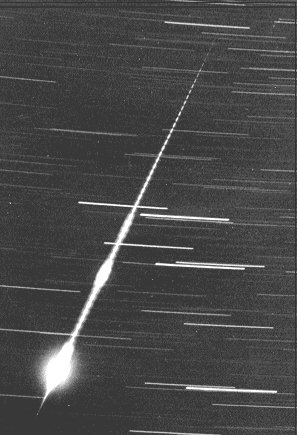|
 |
DMS Photographic- and Video-Database
| dmsprc2000.xls.zip Photographic orbital elements (Microsoft Excel 2000 - 244 kB) |
| dmsprc2000.mdb.zip Photographic orbital elements (Microsoft Access 2000 - 900 kB) |
DMS Photographic- and Video-Database
| dmsvid01.txt Video orbital elements (ASCII text - 235 kB) |
| dmsvid01.xls Video orbital elements (Microsoft Excel 97 - 801 kB) |
DMS Photographic- and Video-Database (Updated April 27, 2003)
Between 1972 and 2002 more than 5000 meteors have been photographed by two or more stations of the small camera network of the Dutch Meteor Society. Most multi station events were photographed in the Netherlands but also many orbital and trajectory data were gathered at expeditions abroad. Data from the Californian network (from 1994 and 1997) are also reduced by the Dutch Meteor Society and the results are included in the database. Out of all multi station events 1344 meteors yielded orbital data. The 2001 version of the DMS photographic database consists of all photographic orbits obtained from the early beginning of the Dutch Meteor Society in the seventies until and including 2001. Next update is expected mid 2004 and will include orbits of the 2002 Perseid shower.
| dmsprc2001.xls.zip | dmsprc2001.mdb.zip |
| (Microsoft Excel 2000 - 316 kB) | (Microsoft Access 2000 - 920 kB) |
Both files can be downloaded as .zip files.
For information, comments and other formats please contact:
Hans Betlem at photo@dmsweb.org
DMS Photographic- and Video-Database (Updated November 6, 2001)
The DMS video database contains now orbital and trajectory data of 742 video multistation meteors, photographed by the Dutch Meteor Society up til 2000. Orbital data of the 1995 Quadrantids, the 1995 Leonids and alpha Monocerotids and the 1993-1998 Perseid (outbursts) streams have been published in several journals. See the DMS publications list, abstract service and full papers on the DMS web site and DMS ftp site. Now the full table of video data 1972-2000 is available in Microsoft Excel format (version 97) and in ASCII text format on the DMS ftp site.
| dmsvid01.txt | dmsvid01.xls |
| (ASCII text - 235 kB) | (Microsoft Excel 97 - 801 kB) |
Hans Betlem at photo@dmsweb.org or
Marc de Lignie at video@dmsweb.org
DMS Photographic- and Video-Database
- Betlem, H. et. al. DMS photographic meteor database. Leiden, 1995.
- Lindblad, B.A., 1987, in (eds.) Z. Ceplecha and P. Pecina, Interplanetary Matter, Proc. 10th European Reg. Meeting of the IAU, vol. 2, Praghe, pp. 201-204
- Lindblad, B.A., 1991, in (eds.) A.C. Levasseur-Regourd and H. Hasegawa, Origin and Evolution of Interplanetary Dust, Kluwer Adad. Publishers, pp. 311-314
DMS Photographic- and Video-Database
| CODE | ###### | DMS filing code |
|---|---|---|
| YEAR | #### | |
| MONTH | ## | |
| DAY | ##.#### | Decimal date |
| N | ## | Number of available photographs |
| STREAM | ##### | Shower identification |
| Mv | ## | Estimated visual magnitude |
| q | #.### | perihelion distance [AU] |
| tol q | #.### | standard deviation in q [AU] |
| Q | #####.### | aphelion distance Q [AU] |
| a | ###.### | semi major axis [AU] |
| 1/a | #.### | Inverse semi majox axis [1/AU] |
| tol 1/a | #.### | standard deviation in 1/a [1/AU] |
| e | #.### | excentricity of the orbit |
| tol e | #.### | standard deviation in excentricity |
| i | ###.## | inclination (J2000.0) [degrees] |
| tol i | #.## | standard deviation in i [degrees] |
| omega | ###.## | perihelion lenght (J2000.0) [degrees] |
| tol omega | ##.## | standard deviation in omega [degrees] |
| node | ###.#### | node (J2000.0) [degrees] |
| tol node | #.#### | standard deviation node [degrees] |
| pi | ###.## | pi (J2000.0) [degrees] |
| tol pi | ##.## | standard deviation pi [degrees] |
| Vg | ##.## | Geocentric velocity [km/s] |
| Vh | ##.## | Heliocentric velocity [km/s] |
| V inf | ##.## | V inf [km/s] |
| V | ##.## | V mean [km/s] |
| tol V | #.# | standard deviation in V inf [km/s] |
| H beg. | ###.# | Height of beginning [km] |
| H max. | ###.# | Height of maximum light [km] |
| H end | ###.# | Terminal height [km] |
| RA | ###.## | RA observed radiant (2000.0) [degrees] |
| tol RA | #.## | standard deviation in RA [degrees] (only given when N>2) |
| DEC | ##.## | DECL observed radiant (2000.0) [degrees] |
| tol DEC | #.## | standard deviation in DEC [degrees] (only given when N>2) |
| RA Geo | ###.## | RA Geocentric radiant (2000.0) [degrees] |
| DEC Geo | ##.## | DECL geocentric radiant (2000.0) [degrees] |
| COSZR | #.## | Cos zenit distance of the radiant. |
| Q max | ##.# | maximum Q angle between the meteor trails on the meteor images |
Photographic and video databases
at the DMS FTP-site
